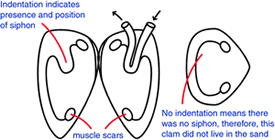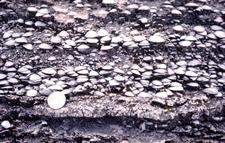|
|
||
|
| ||
|
Reconstructing the anatomy of fossil mollusks
Figuring out how muscles and other soft tissues looked and functioned can be difficult if the shell is the only part of the animal that remains. Hickman overcomes this obstacle by looking closely at marks these soft tissues have created on the inside surface of the shell, as illustrated below (click for an enlarged version).  For example, indentations on the inner surface reveal where muscles once attached to the shell. According to Hickman, the way that muscles attach to the shell tells us much about the range of movements that were possible for the living animal.
|
Investigating past interactions
Hickman explains that in the case of the Rottnest Island shells and opercula, “These are accumulations in which two distinctive parts of the same animal have become separated into different areas. We are able to infer very strongly from the nature of the accumulation that sea birds were responsible for their creation. They were cracking shells over in one place and carrying the soft parts over to another place (with the opercula still attached) to eat it. Then the birds barfed up the undigested opercula, creating an accumulation separate from the shells.”  Visit Bioforum 2000 for more about what Hickman learns from fossils in the field, including sites such as this shell accumulation on Rottnest Island. |
|
| Browse the Profile: Profile | Research | Techniques | On Science | ||
| Home | What’s new | About UCMP | History of life | Fossil collections | Other resources | ||

